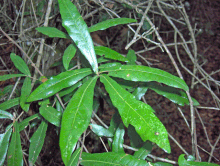Darlington Oak
| Quercus hemisphaerica | |
|---|---|
 |
|
| Scientific classification | |
| Kingdom: | Plantae |
| (unranked): | Angiosperms |
| (unranked): | Eudicots |
| (unranked): | Rosids |
| Order: | Fagales |
| Family: | Fagaceae |
| Genus: | Quercus |
| Section: | Lobatae |
| Species: | Q. hemisphaerica |
| Binomial name | |
|
Quercus hemisphaerica Bartram ex Willd. 1805 not Drake 1890 nor Endl. 1848 |
|
| Synonyms | |
|
List
|
|
Quercus hemisphaerica (sand laurel oak, laurel oak, Darlington oak, laurel-leaf oak) is a species of oak native to the southeastern and south-central United States, from Texas to Delaware. It is in the red oak section Quercus sect. Lobatae. It is often confused with and closely related to the Quercus laurifolia (swamp laurel oak) in which it differs in several key characteristics.
Quercus hemisphaerica is a medium-sized evergreen to semi-evergreen tree which can grow as tall as 115 feet (35 m) tall with a 5-foot (1.5 m) trunk diameter, although it is more commonly around 60 to 65 feet (18 m-20 m) tall. The leaves are entire, without teeth except one apical awn (rarely with a few teeth near apex), mostly elliptical or narrowly ovate, and 1.2 to 4.7 inches (3 cm to 12 cm) long by 0.4 to 1.6 inches (1 cm to 4 cm) wide. The petiole is very short ranging from 1/25 to 1/5 of an inch(1 mm to 5 mm) long and the leaf base is obtuse to rounded. The acorns are hemispheric in shape and 0.35 to 0.6 inches(9 to 16.5 mm) by 0.35 to 0.6 inches(9 to 16.5 mm). The acorns take 18 months to mature and are 1/4 to 1/3 covered by a saucer to bowl shaped cap.
It grows in somewhat xeric sandy soils, sand hills, and sometimes on hillsides.
There is at least one known hybrid involving Quercus hemisphaerica which is with Q. laevis (Q. × mellichampii Trel.).
...
Wikipedia
